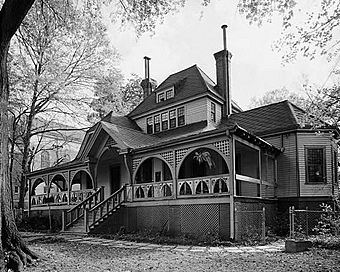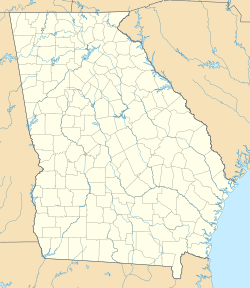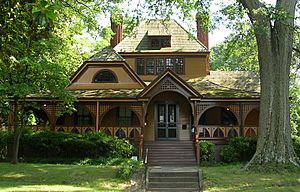Joel Chandler Harris House facts for kids
|
Joel Chandler Harris
|
|

HABS photo from 1985
|
|
| Location | Ralph D. Abernathy Blvd., SW, Atlanta, Georgia |
|---|---|
| Area | 3 acres (1.2 ha) |
| Built | 1870 |
| Architectural style | Late Victorian |
| NRHP reference No. | 66000281 |
Quick facts for kids Significant dates |
|
| Added to NRHP | October 15, 1966 |
| Designated NHL | December 19, 1962 |
The Joel Chandler Harris House, also known as The Wren's Nest, is a historic home in Atlanta, Georgia. It was built in 1870 and became the home of Joel Chandler Harris in 1881. Harris was a famous writer and editor. He wrote the popular Uncle Remus Tales. He lived in this house until he passed away in 1908.
The house is very important because of its connection to Joel Chandler Harris. It was named a National Historic Landmark in 1962. This means it's a special place recognized for its history. Today, it is a historic house museum where people can visit and learn about Harris and his stories.
Contents
The Story of the Wren's Nest
The house was built around 1868. At that time, the area was known for its fancy homes. Joel Chandler Harris first rented the house in 1881. Two years later, he bought it. He was able to buy it thanks to the money he earned from his first book, Uncle Remus: Songs and Sayings.
Harris lived in the house for many years. In 1884, he made some changes to it. He added six new rooms and updated the outside look. Around 1900, the house got modern updates like a furnace, indoor plumbing, and electricity.
How the House Got Its Name
Joel Chandler Harris first called his home Snap Bean Farm. This was a playful nod to another writer's home. But the house got its most famous name, "Wren's Nest," in a special way.
In the spring of 1895, Harris found a family of wrens living in his mailbox. He loved this discovery! The family decided to build a new mailbox so the wrens could stay in their nest. This sweet event led to the house being called "The Wren's Nest."
A Home for Creativity
While living in this house, Joel Chandler Harris was very busy. He wrote more than twenty books there! He also wrote many articles for the Atlanta Constitution newspaper. He even had his own magazine, The Uncle Remus Home Magazine.
In 1900, a famous poet named James Whitcomb Riley visited Harris at the Wren's Nest. Harris's children really liked Riley and called him Uncle Jeems.
The Wren's Nest Today
After Joel Chandler Harris passed away, people wanted to keep his home special. A rich businessman named Andrew Carnegie gave $5,000 to help turn the house into a museum. He had visited Harris there years before.
From 1913 to 1953, a group of volunteers called the Uncle Remus Memorial Association managed the house. They made sure it stayed open as a museum. In 1983, the group changed its name to the Joel Chandler Harris Association.
Today, the Wren's Nest still has many of Harris's original belongings. You can see the furniture he used and the original paint colors on the walls. The original mailbox, which inspired the name "Wren's Nest," was recreated in 1991.
The organization that takes care of the Wren's Nest offers tours. They also have regular storytelling events, bringing Harris's tales to life. They even have writing programs for young people in Atlanta. These programs help high school students create their own literary journal.
See also





